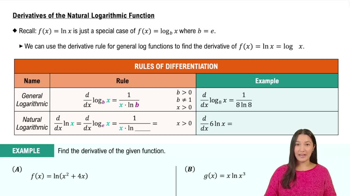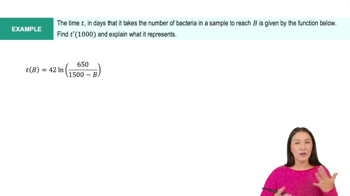Table of contents
- 0. Functions7h 52m
- Introduction to Functions16m
- Piecewise Functions10m
- Properties of Functions9m
- Common Functions1h 8m
- Transformations5m
- Combining Functions27m
- Exponent rules32m
- Exponential Functions28m
- Logarithmic Functions24m
- Properties of Logarithms34m
- Exponential & Logarithmic Equations35m
- Introduction to Trigonometric Functions38m
- Graphs of Trigonometric Functions44m
- Trigonometric Identities47m
- Inverse Trigonometric Functions48m
- 1. Limits and Continuity2h 2m
- 2. Intro to Derivatives1h 33m
- 3. Techniques of Differentiation3h 18m
- 4. Applications of Derivatives2h 38m
- 5. Graphical Applications of Derivatives6h 2m
- 6. Derivatives of Inverse, Exponential, & Logarithmic Functions2h 37m
- 7. Antiderivatives & Indefinite Integrals1h 26m
- 8. Definite Integrals4h 44m
- 9. Graphical Applications of Integrals2h 27m
- 10. Physics Applications of Integrals 2h 22m
6. Derivatives of Inverse, Exponential, & Logarithmic Functions
Derivatives of Exponential & Logarithmic Functions
Problem 3.9.62
Textbook Question
The graph of y =xln x has one horizontal tangent line. Find an equation for it.
 Verified step by step guidance
Verified step by step guidance1
Step 1: Recognize that a horizontal tangent line occurs where the derivative of the function is zero. Therefore, we need to find the derivative of the function y = x^{\ln x}.
Step 2: To differentiate y = x^{\ln x}, use logarithmic differentiation. Start by taking the natural logarithm of both sides: \ln y = \ln(x^{\ln x}) = \ln x \cdot \ln x.
Step 3: Differentiate both sides with respect to x. The left side becomes \frac{1}{y} \cdot \frac{dy}{dx} using the chain rule, and the right side becomes \frac{d}{dx}(\ln x \cdot \ln x) using the product rule.
Step 4: Apply the product rule to differentiate \ln x \cdot \ln x: \frac{d}{dx}(\ln x \cdot \ln x) = \ln x \cdot \frac{1}{x} + \ln x \cdot \frac{1}{x} = 2 \cdot \frac{(\ln x)}{x}.
Step 5: Substitute back to find \frac{dy}{dx}: \frac{1}{y} \cdot \frac{dy}{dx} = 2 \cdot \frac{(\ln x)}{x}. Solve for \frac{dy}{dx} and set it to zero to find the x-value where the tangent is horizontal.
 Verified video answer for a similar problem:
Verified video answer for a similar problem:This video solution was recommended by our tutors as helpful for the problem above
Video duration:
4mPlay a video:
Was this helpful?
Key Concepts
Here are the essential concepts you must grasp in order to answer the question correctly.
Derivative
The derivative of a function measures the rate at which the function's value changes as its input changes. It is a fundamental concept in calculus used to find slopes of tangent lines. For a function to have a horizontal tangent line, its derivative must equal zero at that point.
Recommended video:

Derivatives
Critical Points
Critical points occur where the derivative of a function is either zero or undefined. These points are essential for identifying local maxima, minima, and points of inflection. In the context of the given function, finding critical points will help determine where the horizontal tangent line exists.
Recommended video:

Critical Points
Exponential and Logarithmic Functions
The function y = x ln x involves both polynomial and logarithmic components. Understanding the properties of logarithmic functions, such as their growth rates and behavior, is crucial for analyzing the function's graph and finding its derivative. This knowledge aids in solving for the horizontal tangent line effectively.
Recommended video:

Derivatives of General Logarithmic Functions

 4:50m
4:50mWatch next
Master Derivatives of General Exponential Functions with a bite sized video explanation from Callie
Start learningRelated Videos
Related Practice













